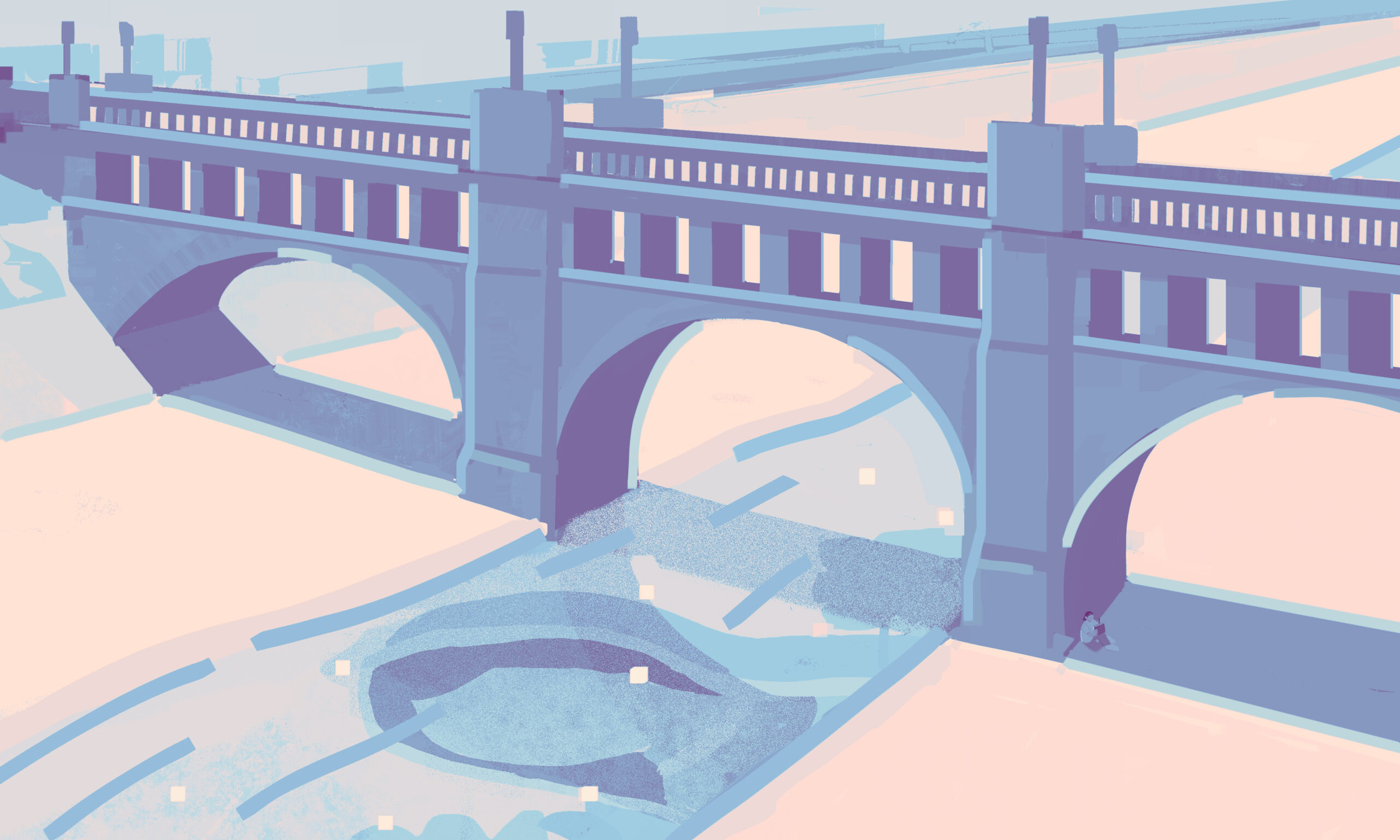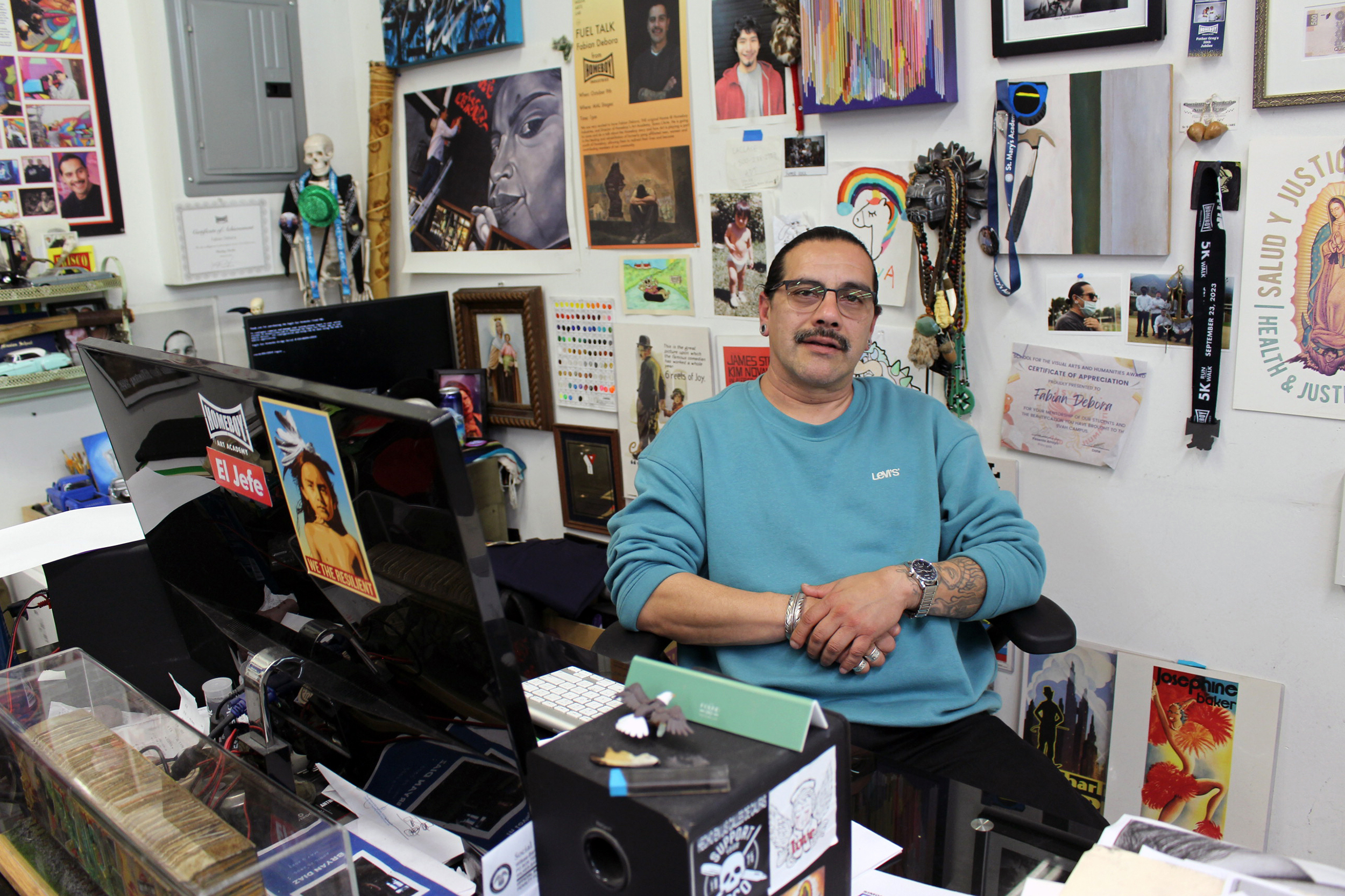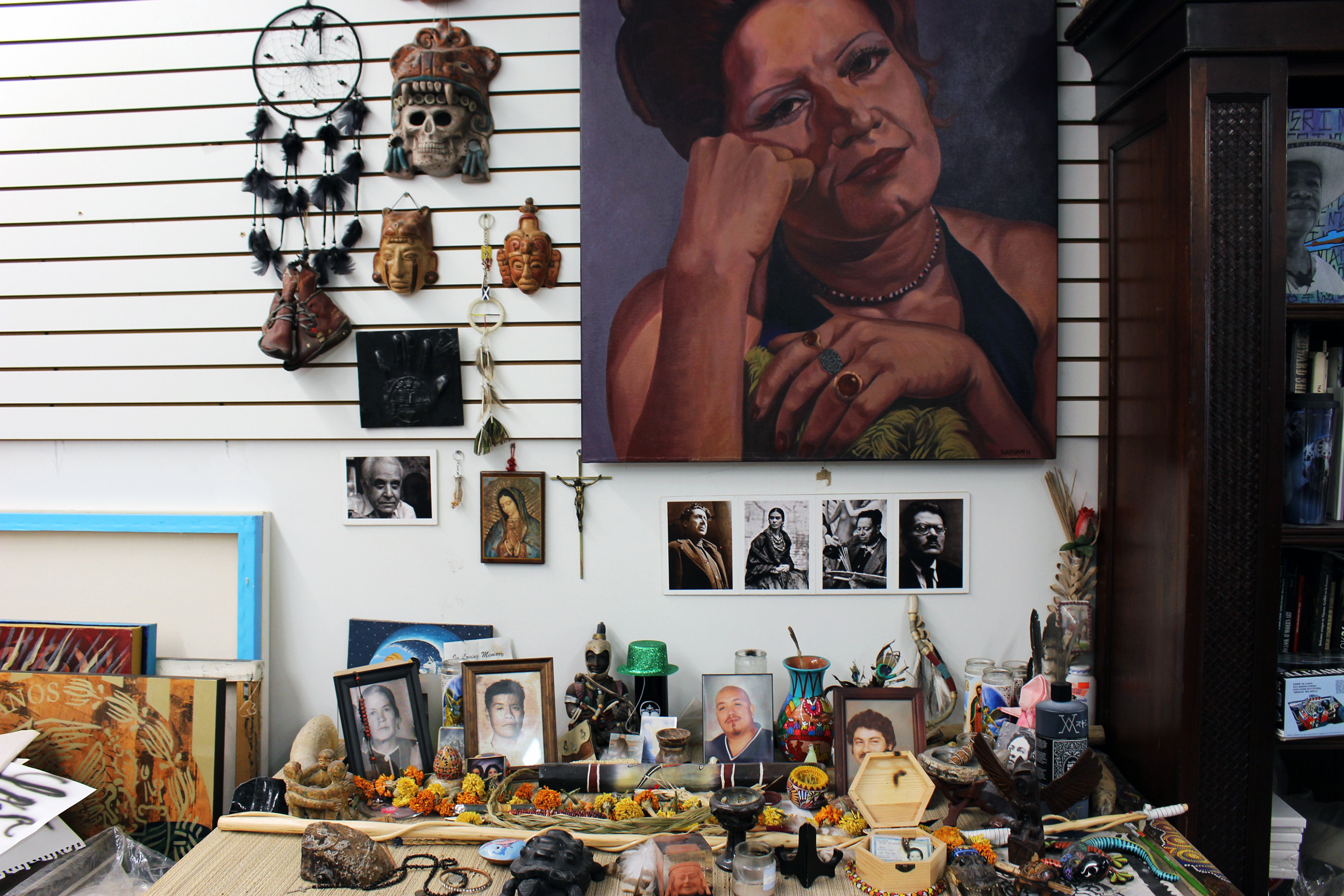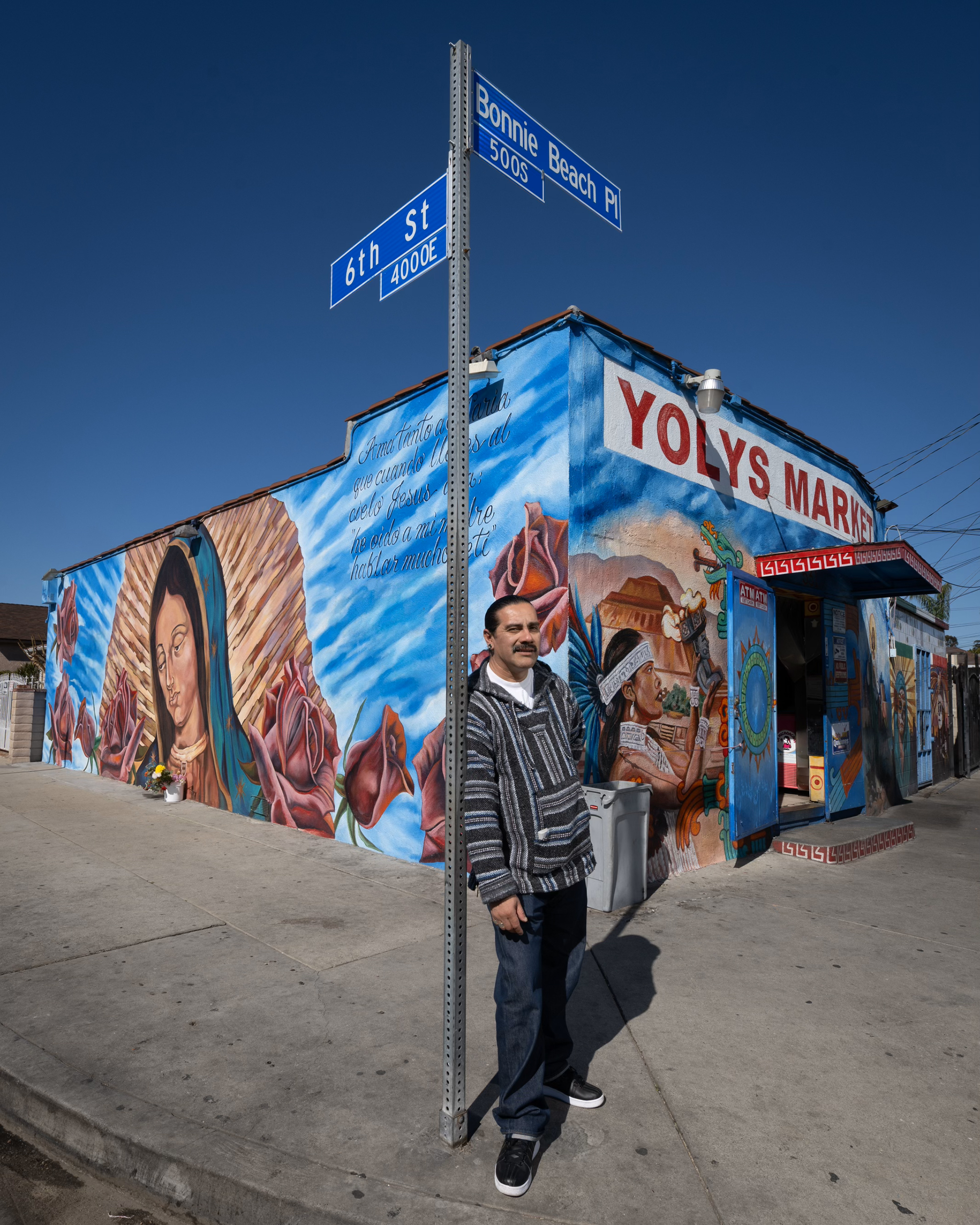
EMILY WHANG / NEXTGENRADIO
Brandon Killman speaks with Fabian Debora, prolific L.A. street artist and executive director of Homeboy Art Academy, about his home in the changing neighborhood of Boyle Heights. They talk about how his community shaped his life trajectory from being a former gang member to being sober and a respected community leader.
Finding Home Through Art, Beauty and Grime
This story contains a mention of a suicide and may be upsetting to some readers.
Listen to the Story
Click here for audio transcript
Fabian Debora:
I always thought the L.A. River was like the main artery that comes from the heart of Los Angeles, because in that L.A. River, it’s also a sense of peace. It’s almost like a city away from the city.
My name is Fabian Debora. I’m an artist of Boyle Heights, and I’m also the founder and executive director of the Homeboy Art Academy.
To me, home is Los Angeles. To be a little bit more specific, I would say Boyle Heights, the East Side. El este de Los Ángeles.
I’ve seen a lot with these eyes, and some of the things I saw, I wouldn’t recommend for anyone, or even wish on anyone.
It’s a pretty scary place, especially when you’re in this addiction, And, you know, there’s death, right, violence. There’s … there’s a lot of things that one does, in order to survive.
In between culture, familia, immigrants, there was gangs.
And as a kid, you know, that wasn’t what I wanted to do. I didn’t grow up saying, “I’m going to be a gang member when I grow up.” But because of the environments we come from, you know, in between beauty, there’s grime.
So the L.A. River played a major role in my life, where I would go down there, I will bring my sketchbooks, sometimes my spray cans, and I will start to create my own worlds.
And so for me the L.A. River will be a refuge. A way to get away from the housing projects.
I always respond to those bridges because it’s almost a sense of transcendence from the East Side to the West Side. Right? Like evolution, growth, hope.
I started to unpackage everything that I was running from, what I was running from, was that of abuse, neglect, abandonment, everything that my father instilled behind his drug addiction.
And I said, I’m gonna pick up the pieces of the puzzle where my father left off, and I’m going to continue pushing and doing what we have to do.
As I start to change my life, I start to make sure that there is no more abuse, neglect, and abandonment in my household, but that there’s nothing but love, compassion and understanding. Everything a child needs to sustain his innocence.
And if it wasn’t for those experiences that one goes through, and has gone through, then there’s no appreciation for life.
I come to the studio at 4 a.m.
[Sounds of brush strokes]
And I continue to create for myself. By eight o’clock, the doorbell rings, ding ding and the youth start to arrive to the academy.
[Sounds of people talking in the studio]
So it’s time to put the brush down, close the portal and be attentive to the youth.
We’re currently at the Homeboy Art Academy, which is the school of arts that I, for a long time, had envisioned to put together, right. I’m working with 18- to 25-year-old gang-involved youth, young men and women, and we provide all arts disciplines with the healing element.
The minute that I got clean and sober, I knew that I wanted to do something about this. And I didn’t want to continue to create a gap that exists within our environments in our communities.
And thank God I was still here and that I’m still alive, to be able to convey this message not only for yourself, but for those who need to hear it, to let the world know that there is, that there is a possibility of change.
And I think there’s a lot of change happening, that is given those opportunities, you know, for folks like myself, and the new generations to come.
And I say that behind the culture, behind the tradition, behind my mother’s love and my wife, who stuck by me regardless of what I’ve done, and now my children, then I say, that’s home.
Debora, a long-time resident of Boyle Heights, prolific artist and former gang member is now the executive director of Homeboy Art Academy. “I made it a responsibility and a way of making amends to my community, for I terrified it at one point in my life,” Debora said.
He founded the organization in 2008 with a mission to provide a space for gang-involved youth to heal and transform their lives through art.

Fabian Debora sits at his desk at Homeboy Studios in Los Angeles on March 11, 2024. “I’ve always wanted to have an art academy and be able to utilize the arts and provide those spaces that I didn’t have when I was growing up,” Debora says.
BRANDON KILLMAN / NEXTGENRADIO
Growing up in East L.A.
“The aromas and the early morning canelas smell, with cafe and menudo,” Debora described, “all that good stuff our grandmothers and mothers were cooking at the time.”
While the housing projects were a through line to his fondest memories of his culture, Debora also recalls the toxic gang culture that plagued the streets of his neighborhood, and the rise of the crack cocaine epidemic. A lifestyle that he would become familiar with in the late ‘80s and early ‘90s.
“I didn’t grow up saying ‘I’m gonna be a gang member when I grew up,’ but because of the environments we come from, between the beauty, there’s grime,” Debora said.

Debora arranged this “portal” to the spirit world in the back of his studio, where people who pass through can leave a memento. The area is anchored by a portrait of his mother.
BRANDON KILLMAN / NEXTGENRADIO
Steeped in a drug addiction, it took him a near-death experience to find purpose in his artwork, his life as a father and as a mentor.
“I used to think that the way that I can protect my children was to kill myself.” In an attempt to end his life, he ran across the I-5 freeway. “When I ran across the freeway, God said otherwise,” Debora added.
“I start to make sure that there is no more abuse, neglect, and abandonment in my household, but that there’s nothing but love, compassion and understanding everything a child needs to sustain his innocence,” Debora said.
“I didn’t grow up saying ‘I’m gonna be a gang member when I grew up,’ but because of the environments we come from, between the beauty, there’s grime.”
Where is home now?
Debora has seen Boyle Heights in different phases in his life, and through his self-healing journey he has also been able to nurture the community around him. Down the street from the art academy on 6th Street and Bonnie Beach Place, Yolys Market is the canvas of one of Debora’s murals.
He first completed it in 2007 when he was still struggling with a drug addiction, but revisited the building in 2018 when he got sober to revise the mural. The new mural is a 20 feet wide and 10 feet tall close up of the Virgin Mary and the painting extends to the front door, the store sign and its trimmings. That corner had a history of violence, according to Debora.
“I thought that Virgin Mary would neutralize and bring a sense of peace and it also has given the mothers and our leaders from their community a place to come to congregate,” Debora said. Every year on December 12th the mural is adorned with flowers and celebrated with a live banda on Día de la Virgen de Guadalupe.
For Debora, his home, his art studio and the streets of Boyle Heights are all spaces he calls home in his contemporary life. Through his advocacy it has become his mission to reverse the gang culture, abuse and addiction that used to plague his life from his childhood.
“If it wasn’t for those experiences, that one goes through, and has gone through, then there’s no appreciation for life,” Debora said.

Pictured here in February 2024, Debora stands in front of Yolys Market, which he had originally painted in 2003. He repainted the market with this mural in 2018 after getting sober.
PHOTO COURTESY OF EDDIE RUVALCABA
If you or someone you know may be considering suicide, contact the National Suicide Prevention Lifeline at 1-800-273-8255 (En Español: 1-888-628-9454; Deaf and Hard of Hearing: 1-800-799-4889) or the Crisis Text Line by texting 741741.
